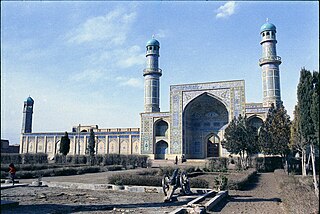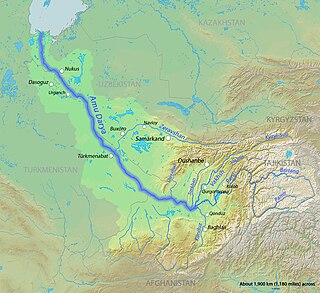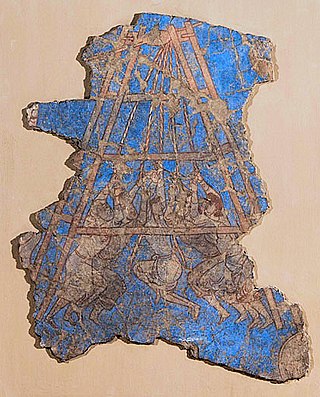
The Muslim conquests of Afghanistan began during the Muslim conquest of Persia as the Arab Muslims migrated eastwards to Khorasan, Sistan and Transoxiana. Fifteen years after the battle of Nahāvand in 642 AD, they controlled all Sasanian domains except in Afghanistan. Fuller Islamization was not achieved until the period between 10th and 12th centuries under Ghaznavid and Ghurid dynasties who patronized Muslim religious institutions.

Herāt is an oasis city and the third-largest city in Afghanistan. In 2020, it had an estimated population of 574,276, and serves as the capital of Herat Province, situated south of the Paropamisus Mountains in the fertile valley of the Hari River in the western part of the country. An ancient civilization on the Silk Road between West Asia, Central Asia, and South Asia, it serves as a regional hub in the country's west.
Year 651 (DCLI) was a common year starting on Saturday of the Julian calendar. The denomination 651 for this year has been used since the early medieval period, when the Anno Domini calendar era became the prevalent method in Europe for naming years.

The Muslim conquest of Persia, also called the Muslim conquest of Iran, the Arab conquest of Persia, or the Arab conquest of Iran, was a major military campaign undertaken by the Rashidun Caliphate between 632 and 654. As part of the early Muslim conquests, which had begun under Muhammad in 622, it led to the fall of the Sasanian Empire and the eventual decline of Zoroastrianism, which had been predominant throughout Persia as the nation's official religion. The persecution of Zoroastrians by the early Muslims during and after this conflict prompted many of them to flee eastward to India, where they were granted refuge by various kings.

Greater Khorasan is a historical eastern region in the Iranian Plateau in West and Central Asia that encompasses western and northern Afghanistan, northeastern Iran, the eastern halves of Turkmenistan and Uzbekistan, western Tajikistan, and portions of Kyrgyzstan and Kazakhstan.

Banū Tamīm is an Arab tribe that originated in Najd in the Arabian Peninsula. It is mainly present in Saudi Arabia, Qatar, Kuwait, Iraq, Jordan and Lebanon, a strong presence in Algeria, and Morocco, Palestine, Tunisia, and Libya. It is also present in many other parts of the Arab world such as Egypt and Khuzestan in Iran. The word Tamim in Arabic means strong and solid. It can also mean those who strive for perfection.
Abu Bahr Al-Ahnaf ibn Qays was a Muslim commander who lived during the time of Islamic prophet Muhammad. He hailed from the Arab tribe of Banu Tamim and was born of noble parents. Initially, his father named him ad-Dhahhak, but people called him al-Ahnaf, which meant "the clubfooted" in classical Arabic. Al-Baladhuri, however, noted that he was also identified as Abdallah ibn Khazim.

Umar was the second Rashidun Caliph and reigned during 634–644. Umar's caliphate is notable for its vast conquests. Aided by brilliant field commanders, he was able to incorporate present-day Iraq, Iran, Azerbaijan, Armenia, Georgia, Syria, Jordan, Palestine, Lebanon, Egypt, and parts of Afghanistan, Turkmenistan and south western Pakistan into the Caliphate. During his reign, the Byzantines lost more than three fourths of their territory and in Persia, Umar became the king (ruler) of Iran after the fall of the Sassanid Empire.
Abū ʿAbd al-Raḥmān ʿAbd Allāh ibn ʿĀmir ibn Kurayz was a Rashidun politician and general. He served as the governor of Basra from 647 to 656 AD, during the reign of Rashidun Caliph Uthman ibn Affan. Through his father's lineage, he was a cousin of the Caliph. He is renowned for his administrative and military prowess, particularly for his successful campaigns of reconquest and pacification in the former territories of the Sasanian Empire, in what is now present-day Iran and Afghanistan.
The Rashidun army was the core of the Rashidun Caliphate's armed forces during the early Muslim conquests in the 7th century. The army is reported to have maintained a high level of discipline, strategic prowess and organization, granting them successive victories in their various campaigns.

The Battle of al-Qadisiyyah was an armed conflict which took place in 636 CE between the Rashidun Caliphate and the Sasanian Empire. It occurred during the early Muslim conquests and marked a decisive victory for the Rashidun army during the Muslim conquest of Persia.

The 3rd Rashidun Caliph, Uthman continued the policy of military expansion carried out by his predecessors, Umar and Abu Bakr. During his reign, the caliphate stretched from Tripolitania, Egypt, and Anatolia to Greater Khorasan and Sindh and reached its greatest extent in 654 CE. However, these conquests were halted when a rebellion began in Egypt which led to his murder, and began the first Fitna.

The Battle of Rasil was fought between the Rashidun Caliphate and the Rai kingdom ruled by Raja Rasil in early 644. It was the first encounter of the Rashidun Caliphate in the Indian subcontinent. The exact location of the battle is not known, but historians suggest it was fought on the western bank of the River Indus.

The Battle of Oxus River was a significant battle in the 7th century, fought between the combined armies of the Sassanid and Göktürk Empires against the Muslim Arab army that had overrun Persia. Following his defeat, the last Sassanid Emperor, Yazdegerd III, became a hunted fugitive who fled to Central Asia and then to China.

The Muslim conquest of Transoxiana or Arab conquest of Transoxiana were the 7th and 8th century early Muslim conquests by the Umayyad and Abbasid Caliphates of of Transoxiana, the land between the Amu Darya or Oxus and the Syr Darya or Jaxartes, a part of Central Asia that today includes all or parts of Uzbekistan, Tajikistan, Kazakhstan, and Kyrgyzstan.
Arfajah ibn Harthama al-Bariqi was a companion of the Islamic prophet Muhammad. He was a member of the Azd branch of the Bariq clan that inhabited Southwestern Arabia.

The Dabuyid dynasty, or Gaubarid dynasty, was a Zoroastrian Iranian dynasty that started in the first half of the 7th century as an independent group of rulers that ruled over Tabaristan and parts of western Khorasan. Dabuyid rule over Tabaristan and Khorasan lasted from around 642 to the Abbasid conquest in 760.

The Principality of Chaghaniyan, known in Arabic sources as al-Saghaniyan, was a part of the Hephthalite Confederation from the 5th to the 7th century CE. After this, it was ruled by a local, presumably Iranian dynasty, which governed the Chaghaniyan region from the late 7th-century to the early 8th-century CE. These rulers were known by their titles of “Chaghan Khudah”.

The Muslim conquest of Khorasan, or Arab conquest of Khorasan, was the last phase of the heavy war between the Arab Rashidun caliphate against the Sasanid Empire.
In 633 CE, the Arab invasion of Iran began, and finally in 654 CE it would lead to the fall of the Sassanid Empire and Iran would come under the rule of the Rashidun, Umayyad and Abbasid caliphs.














